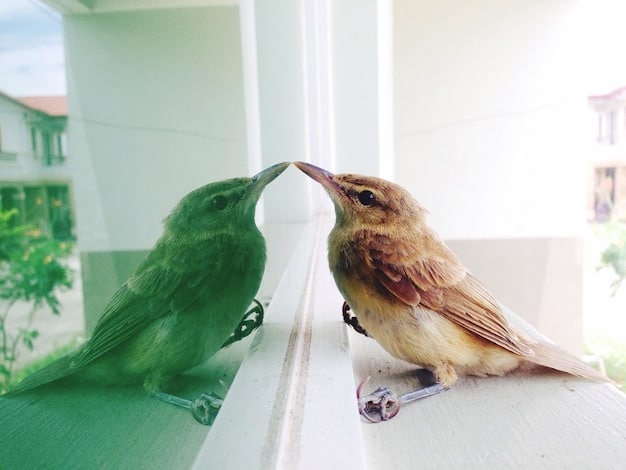The Science of Birdsong: Unlocking Avian Communication & Social Behavior

The science of birdsong explores how acoustic communication through songs and calls shapes avian social behavior, influencing mating, territory defense, and group cohesion.
The intricate melodies and varied calls of birds are more than just pleasant background music; they are a sophisticated form of communication that plays a crucial role in avian social interactions. Understanding the science of birdsong offers a window into the complex world of birds, revealing how acoustic signals influence their behavior, relationships, and survival.
What is Birdsong and Why Does it Matter?
Birdsong, characterized by its complex sequences of notes and phrases, differs from simple calls and serves a variety of vital roles in avian life. It’s not just about making noise; it’s about conveying information, establishing identity, and negotiating social dynamics.
Understanding why birds sing and how their songs affect their behavior provides insights into evolution, ecology, and even the complexities of human language.
Distinguishing Birdsong from Bird Calls
Birdsong generally consists of longer, more complex vocalizations than calls, which tend to be shorter and simpler. Songs are often associated with mating rituals and territorial defense, while calls serve more immediate purposes, such as warning of predators or maintaining contact within a flock.
- Complexity: Songs feature a more complex arrangement of notes and phrases.
- Function: Songs are used for courtship and territoriality; calls are for alarms and contact.
- Learning: Song development involves learning; calls are often innate.
The distinction between songs and calls is not always clear-cut, and some birdsongs can incorporate elements of both. However, the complexity and context typically define whether a vocalization is classified as song or call.
The Acoustic Properties of Birdsong
The acoustic properties of birdsong, including its frequency, duration, and structure, are carefully crafted to effectively transmit information in specific environments. These properties can influence how far a song travels, how easily it is detected by receivers, and what specific messages it conveys.
By analyzing the acoustic features of birdsongs, scientists can gain valuable insights into their function and evolution.
Frequency and Amplitude
Frequency refers to the pitch of a sound, while amplitude is its loudness. Birds adjust these properties to optimize communication in different habitats. For example, low-frequency songs travel farther in dense forests, while high-frequency songs are more effective in open fields.
Amplitude also plays a crucial role in conveying urgency or aggression in birdsongs. Louder songs can signal heightened territorial defense or competition.

Song Structure and Syntax
The way notes and phrases are arranged in a song, its structure and syntax, carries meaning. Just like human languages, birdsong follows rules and patterns that allow birds to create diverse and meaningful messages.
- Note Order: Different sequences of notes can signal different intentions.
- Phrase Repetition: Repeating phrases may emphasize certain aspects of the message.
- Tempo: The speed at which a song is sung can affect its perceived urgency or attractiveness.
Variations in song structure can also serve as individual signatures, allowing birds to recognize each other even from a distance.
How Birds Learn to Sing
The process by which birds learn to sing is complex, involving both genetic predisposition and environmental influence. Some birds have innate song templates that are refined through learning, while others acquire their songs entirely from their environment.
Studying how birds learn to sing provides insights into the neural mechanisms of vocal learning and the role of social interactions in shaping behavior.
The Role of Genetics vs. Learning
While some aspects of birdsong are genetically determined, such as the basic song structure, learning plays a critical role in refining and modifying these templates. Young birds typically learn by imitating adult singers, often their fathers or other members of their social group.
The interplay between genetics and learning allows birds to adapt their songs to local dialects and changing environmental conditions.
The Neural Pathways Involved in Song Learning
Specific brain regions are dedicated to song learning and production in birds. These regions, collectively known as the song system, include the HVC (high vocal center), RA (robust nucleus of the arcopallium), and Area X. These areas communicate and interact to enable birds to learn, memorize, and produce their songs.
- HVC: Involved in song perception, learning, and production.
- RA: Controls the muscles of the syrinx, the bird’s vocal organ.
- Area X: Plays a role in song plasticity and modification.
Research on the song system has provided valuable insights into the neural basis of vocal learning and its parallels with human language acquisition.
The Social Functions of Birdsong
Birdsong serves a wide range of social functions, from attracting mates and defending territories to coordinating group activities and signaling danger. The specific functions of birdsong can vary depending on the species, social structure, and environmental conditions.
Understanding these functions is critical for understanding the complexities of avian social behavior.
Mate Attraction and Courtship
Male birds often use their songs to attract potential mates, signaling their quality as a partner. Features such as song complexity, repertoire size, and singing rate can influence a female’s choice.
Some birds also use songs to coordinate courtship rituals, with males and females engaging in duet singing.

Territorial Defense
Territorial songs communicate ownership and are used to defend boundaries against rivals. These songs are often loud, aggressive, and repeated frequently to warn intruders.
Birds may adjust their songs to match the songs of their neighbors, effectively creating a shared acoustic space known as a “song neighborhood.”
Cooperation and Social Cohesion
Groups of birds may use songs to coordinate activities, such as foraging, predator avoidance, and migration. These songs help maintain social cohesion and promote cooperation among group members.
- Alarm Calls: Warn of danger and coordinate escape responses.
- Contact Calls: Maintain contact within a flock or family group.
- Group Recognition: Allows birds to identify members of their social group.
The coordinated use of birdsong in social contexts highlights the importance of communication in maintaining complex social systems.
Birdsong in Different Environments
The acoustic characteristics of birdsong vary across different environments. The songs are adapted to maximize transmission efficiency and minimize degradation in specific habitats, such as forests, grasslands, and urban environments.
Studying environmental adaptation of songs highlights how ecology and evolution shape vocal communication in birds.
Forest Environments
Forest environments pose challenges for acoustic communication due to dense vegetation that absorbs and scatters sound. Birds in forests often use low-frequency, long-duration songs that can travel farther through the foliage.
The structure of forest songs may also be adapted to avoid reverberation and echo, common in dense forests.
Grassland Environments
Grassland environments are more open and less cluttered than forests, allowing for higher frequency songs to travel over larger distances. Birds in grasslands often use complex, variable songs to avoid habituation by receivers.
The precise tonal qualities of the songs are crafted in the grasslands to exploit the open acoustics.
Urban Environments
Urban environments present unique challenges for birdsong due to high levels of noise pollution. Birds in cities often sing at higher frequencies and louder amplitudes to overcome background noise.
Some birds have also adjusted the timing of their songs to avoid periods of peak noise, highlighting the adaptability of birdsong in response to anthropogenic changes.
The Future of Birdsong Research
Birdsong research continues to evolve. New technologies, such as automated recording devices and machine-learning algorithms, are providing opportunities for researchers to study birdsong on a scale never before possible.
Future research needs to focus on conserving birdsong.
Technological Advances in Birdsong Analysis
Automated recording devices allow researchers to collect large datasets of birdsong from diverse locations. Machine-learning algorithms can analyze these datasets, identify patterns, and classify songs with high accuracy.
- Bioacoustic Sensors: Record birdsong continuously over long periods of time.
- Spectrogram Analysis: Visualizes the acoustic structure of birdsong.
- Machine Learning: Automates the identification and classification of songs.
These technological advances have opened new avenues for exploring the complexities of birdsong and its role in avian communication.
Conservation Implications of Birdsong Research
Understanding birdsong is useful for conservation. Birdsong can be used to monitor bird populations, assess habitat quality, detect invasive species, and evaluate the effectiveness of conservation interventions.
Protecting bird habitats is essential for preserving the acoustic diversity of birdsong and ensuring the survival of songbird species.
| Key Point | Brief Description |
|---|---|
| 🎶 Birdsong vs. Calls | Complex songs for mating & territory; simple calls for alarms. |
| 🔊 Acoustic Properties | Frequency, duration, and structure adapt to the environment. |
| 🧠 Learning Process | Involves genetics & imitation; neural pathways refine songs. |
| 🤝 Social Functions | Attract mates, defend territories, and coordinate group activities. |
Frequently Asked Questions About Birdsong
▼
Birds sing early in the morning because the air is calm, allowing their songs to travel farther. Also, it’s before other daytime activities begin, reducing background noise.
▼
Not all birds sing; usually, it’s the male birds that sing to attract mates or defend territory. Female birds often produce calls, which are shorter, simpler vocalizations.
▼
Yes, some birds can change their songs over time. They may learn new songs from other birds or modify their existing songs due to environmental changes or social interactions.
▼
Birds produce sounds using a vocal organ called the syrinx, which is located where the trachea splits into the lungs. They can control the muscles around the syrinx to create a wide range of complex sounds.
▼
Yes, birdsong dialects are real. These are regional variations in songs that are learned and passed down through generations, similar to human language dialects. They often reflect local environmental conditions.
Conclusion
From attracting mates to defending territories, the science of birdsong reveals how birds use acoustic communication to navigate their complex social lives. As technology advances, future research promises even more insights into the intricate world of avian communication, furthering our understanding of social behavior.





